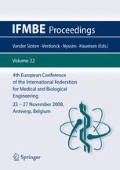Abstract
Breast cancer is the most common cancer in women. Breast MRI (BMRI) has emerged as a promising technique for detecting, diagnosing, and staging the condition. Automated image analysis aims to extract relevant information from MR images of the breast and improve the accuracy and consistency of image interpretation. Texture analysis (TA) is one possible means of detecting tissue features in biomedical images.
The aim of this study was to evaluate the parameters which identify the most important breast cancer characteristics and to assess the ability of MRI-based TA to characterize breast cancer tissue. Seven patients with histopathologically proven breast cancer were included in this preliminary study. The texture analysis was performed with MaZda texture application. The most discriminant texture features identified by Fisher coefficients and POE+ACC (probability of classification error and average correlation coefficients) between breast cancer tissue and reference tissue from the healthy breast and tissue adjoining the cancer area were evaluated. This evaluation was made between patients, different imaging series and two histological types of (ductal vs. lobular) carcinomas. Raw data analysis (RDA), principal component analysis (PCA), linear discriminant analysis (LDA) and nonlinear discriminant analysis (NDA) were run for each subset of images and chosen texture features. The results revealed differences in the textures in every imaging series when non-cancer and cancer tissue were compared and the best discrimination results were obtained within two dynamic contrast-enhanced MRI subtraction series. Furthermore, the texture parameters obtained differed between the two histological groups. The preliminary results show potential in discriminating between normal and abnormal breast tissue elements, encouraging us to continue with larger data sets.
Access this chapter
Tax calculation will be finalised at checkout
Purchases are for personal use only
Preview
Unable to display preview. Download preview PDF.
References
Heywang SH, Wolf A, Pruss E et al. (1989) MR imaging of the breast withGd-DTPA: use and limitations. Radiology 171:95–103
Stack JP, Redmond OM, Codd MB et al. (1990) Breast disease: tissue characterization with Gd-DTPA enhancement profiles. Radiology 174:491–494
Gilles R, Guinebretiere JM, Lucidarme O et al. (1994) Nonpalpable breast tumours: diagnosis with contrast-enhanced subtraction dynamic MR imaging. Radiology 191: 625–31
Padhani AR (2002) Dynamic contrast-enhanced MRI in clinical oncology: Current status and future directions. J Magn Reson Imaging 16: 407–422 DOI 10.1002/jmri.10176
Knopp MV, Weiss E, Sinn HP et al. (1999) Pathophysiologic basis of contrast enhancement in breast tumours. J Magn Reson Imaging 10:260–266
Materka A, Strzelecki M (1998) Texture analysis methods-a review. Technical University of Lodz, Poland: COST B11 Report. http://www.eletel.p.lodz.pl/cost/pdf_1.pdf
Castellano G, Bonilha L, Li LM et al. (2004) Texture analysis of medical images. Clin Radiol. 59:1061–1069 DOI:10.1016/j.crad. 2004.07.008
Haralick R (1979) Statistical and structural approaches to texture. Proc IEEE 67:786–804
Jirak D, Dezortova M, Taimr P et al. (2002) Texture analysis of human liver. J Magn Reson Imaging 15:68–74 DOI:10.1002/jmri.10042
Kovalev VA, Kruggel F, Gertz HJ, et al. (2001) Three dimensional texture analysis of MRI brain datasets. IEEE Trans Med Imaging 20:424–433
Herlidou-Meme S, Constans JM, Carsin B, et al. (2003) MRI texture analysis on texture test objects, normal brain and intracranial tumours. Magn Reson Imaging 21::989–993 DOI:10.1016/S0730-725X(03)00212-1
Gibbs P, Turnbull LW (2003) Textural analysis of contrast-enhanced MR Images of the breast. Magn Reson Med 50:92–98 DOI:10.1002/mrm.10496
Harrison L, Dastidar P, Eskola H, et al(2008) Texture analysis on MRI images of non-Hodgkin lymphoma Comput Biol Med 38:519–24 DOI:10.1016/j.compbiomed.2008.01.016
Gupta R, Undrill PE (1995) The use of texture analysis to delineate suspicious masses in mammography. Phys Med Biol 40:835–855 DOI: 10.1088/0031-9155/40/5/009
Miller P, Astley S (1992) Classification of breast tissue by texture analysis. Image Vis Comput 10:277–283 DOI:10.1016/0262-8856(92)90042-2
Bader W, Böhmer S, van Leeuwen P, et al. (2000) Does texture analysis improve breast ultrasound precision? Ultrasound Obstet Gynecol 15:311–316 DOI:10.1046/j.1469-0705.2000.00046.x
Sinha S, Lucsa-Quesada FA, DeBruhl ND, et al. (1997) Multifeature analysis of Gd-enhanced MR images of breast lesions. J Magn Reson Imaging 7:1016–102 DOI:10.1002/jmri.1880070613
James D, Clymer BD, Schmalbrock P (2001) Texture detection of simulated microcalcification susceptibility effects in magnetic resonance imaging of breasts. J Magn Reson Imaging 13:876–881 DOI:10.1002/jmri.1125
Chen W, Giger ML, Li H, et al. (2007) Volumetric texture analysis of breast lesions on contrast-enhanced magnetic resonance image. Magn Reson Med 58:562–571 DOI:10.1002/mrm.21347
Woods BJ, Clymer BD, Kurc T, et al. (2007) Malignant-lesion segmentation using 4D co-occurrence texture analysis applied to dynamic contrast-enhanced magnetic resonance breast image data. J Magn Reson Imaging 25:495–501 DOI:10.1002/jmri.20837
Hajek M, Dezortova M, Materka A, Lerski R (eds.) (2006) Texture analysis for magnetic resonance imaging. Med4publishing, Prague
Collewet G, Strzelecki M, Mariette F (2004) Influence of MRI acquisition protocols and image intensity normalization methods on texture classification. J Magn Reson Imaging 22:81–91 DOI:10.1016/j.mri.2003.09.001
Holli KK (2008) Detection of characteristic texture parameters in breast MRI Tampere University of Technology, Department of Electrical Engineering, Tampere, Master of Science Thesis
Morris EA and Liberman L (2006) Breast MRI: Diagnosis and Intervention. Springer, New York, at http://www.springerlink.com
Author information
Authors and Affiliations
Corresponding author
Editor information
Editors and Affiliations
Rights and permissions
Copyright information
© 2009 Springer-Verlag Berlin Heidelberg
About this paper
Cite this paper
Holli, K., Lääperi, A.L., Harrison, L., Soimakallio, S., Dastidar, P., Eskola, H.J. (2009). Detection of characteristic texture parameters in breast MRI. In: Vander Sloten, J., Verdonck, P., Nyssen, M., Haueisen, J. (eds) 4th European Conference of the International Federation for Medical and Biological Engineering. IFMBE Proceedings, vol 22. Springer, Berlin, Heidelberg. https://doi.org/10.1007/978-3-540-89208-3_123
Download citation
DOI: https://doi.org/10.1007/978-3-540-89208-3_123
Publisher Name: Springer, Berlin, Heidelberg
Print ISBN: 978-3-540-89207-6
Online ISBN: 978-3-540-89208-3
eBook Packages: EngineeringEngineering (R0)

